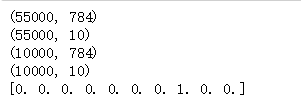THE MNIST DATABASE of handwritten digits(点击进入下载4个数据文件)
加载一下数据集
import numpy as np
import tensorflow as tf
import matplotlib.pyplot as plt
import input_data
import warnings
warnings.filterwarnings("ignore")
mnist = input_data.read_data_sets('data/', one_hot=True)#进行度热编码
trainimg = mnist.train.images
trainlabel = mnist.train.labels
testimg = mnist.test.images
testlabel = mnist.test.labels
print ("MNIST loaded")
print (trainimg.shape)
print (trainlabel.shape)
print (testimg.shape)
print (testlabel.shape)
#print (trainimg)
print (trainlabel[0])
模型建立:
#None(无穷)为输入数据,784为输入数据单个案例的维度(列)
x = tf.placeholder("float", [None, 784])
y = tf.placeholder("float", [None, 10]) # None is for infinite
#对784个维度附上权重w
W = tf.Variable(tf.zeros([784, 10]))
#由于做10分类,因此只需要10个偏置因子b即可
b = tf.Variable(tf.zeros([10]))
# 假设一个模型
#由于逻辑回归为二分类,因此做个转化为softmax分类
#softmax(得分值)=x*w+b
actv = tf.nn.softmax(tf.matmul(x, W) + b)
# 在tf.reduce_sum等函数中,有一个reduction_indices参数,表示函数的处理维度。
# 当没有reduction_indices这个参数,此时该参数取默认值None,将把input_tensor降到0维,也就是一个数
# 损失函数:逻辑回归的为-logP,tf.log(actv)与[0. 0. 0. 0. 0. 0. 0. 1. 0. 0.]相乘,得到对应真实标签的均值
cost = tf.reduce_mean(-tf.reduce_sum(y*tf.log(actv), reduction_indices=1))
# 使用梯度下降对loss函数进行求解
learning_rate = 0.01
optm = tf.train.GradientDescentOptimizer(learning_rate).minimize(cost)模型评估
# 对于预测值label与索引值label是否
pred = tf.equal(tf.argmax(actv, 1), tf.argmax(y, 1))
# tf.cast将pred转化为float,布尔类型转为01,计算准确率
accr = tf.reduce_mean(tf.cast(pred, "float"))
# 初始化
init = tf.global_variables_initializer()模型求解:
#所有样本迭代50次
training_epochs = 50
#一次迭代100个样本
batch_size = 100
display_step = 5
# SESSION
sess = tf.Session()
sess.run(init)
# MINI-BATCH LEARNING
for epoch in range(training_epochs):
#初始化loss=0
avg_cost = 0.
#计算一次迭代100个样本有多少个batch
num_batch = int(mnist.train.num_examples/batch_size)
for i in range(num_batch):
#第一个batch
batch_xs, batch_ys = mnist.train.next_batch(batch_size)
#使用梯度下降法(optm)对每个batch进行求解,
sess.run(optm, feed_dict={x: batch_xs, y: batch_ys})
#计算更新后权重的loss值
feeds = {x: batch_xs, y: batch_ys}
avg_cost += sess.run(cost, feed_dict=feeds)/num_batch
# 每五个epochs输出一下
if epoch % display_step == 0:
feeds_train = {x: batch_xs, y: batch_ys}
feeds_test = {x: mnist.test.images, y: mnist.test.labels}
train_acc = sess.run(accr, feed_dict=feeds_train)
test_acc = sess.run(accr, feed_dict=feeds_test)
print ("Epoch: %03d/%03d cost: %.9f train_acc: %.3f test_acc: %.3f"
% (epoch, training_epochs, avg_cost, train_acc, test_acc))
print ("DONE")
可以看到效果还是较为不错了,测试集准确率达到了0.978